Monday, April 18, 2011
Posted by
n
at
8:12 PM
[Q] ENGLISH a big necessity in clearing IAS and State PSC exam
Got question via email
Ans:
As per new pattern in IAS exam (known as CSAT), there will be compulsory English grammar/ comprehension questions in the prelim paper-II. [its marks will be counted in the prelim-selection list]
In the mains exam of IAS, there is a compulsory english language paper, but its marks are not counted in the final merit list. However, in some State PSCs such as Gujarat, the marks of compulsory English language paper (mains) are counted in the final merit list.
So yes English has became a big necessity for clearing competitive exams be it IAS and State PSC or Bank.
I wanted to ask that is ENGLISH a big necessity in clearing IAS exam and other STATE PSC'S..
Ans:
As per new pattern in IAS exam (known as CSAT), there will be compulsory English grammar/ comprehension questions in the prelim paper-II. [its marks will be counted in the prelim-selection list]
In the mains exam of IAS, there is a compulsory english language paper, but its marks are not counted in the final merit list. However, in some State PSCs such as Gujarat, the marks of compulsory English language paper (mains) are counted in the final merit list.
So yes English has became a big necessity for clearing competitive exams be it IAS and State PSC or Bank.
Sunday, April 17, 2011
Posted by
n
at
10:28 AM
IMPORTANT DAYS FOR UPSC PRELIMS
January | |
27 | |
February | |
2 | world's wetlands day |
March | |
8 | International Women's Day and UN Day for Women's Rights and International Peace |
21 | International Day for the Elimination of Racial Discrimination |
21 March - 28 March | Week of Solidarity with the Peoples Struggling against Racism and Racial Discrimination |
22 | World Water Day |
23 | |
April | |
4 | International Day for Mine Awareness and Assistance in Mine Action |
7 | |
23 | World Book and Copyright Day |
May | |
3 | |
15 | |
17 | World Information Society Day (formerly World Telecommunication Day) |
21 | |
22 | International Day for Biological Diversity (formerly December 29, changed in 2001) |
25 May - 1 June | Week of Solidarity with the Peoples of Non-Self-Governing Territories |
29 | |
31 | World No-Tobacco Day |
June | |
5 | |
17 | |
20 | |
23 | |
26 | International Day Against Drug Abuse and Illicit Trafficking and International Day in Support of Victims of Torture |
July | |
1st Saturday | |
11 | World Population Day |
August | |
9 | International Day of the World's Indigenous People |
12 | International Youth Day |
23 | International Day for the Remembrance of the Slave Trade and its Abolition |
September | |
8 | International Literacy Day |
16 | International Day for the Preservation of the Ozone Layer |
21 | International Day of Peace (formerly the opening day of the UN General Assembly, changed to a set date as of 2002) |
During last week | World Maritime Day |
October | |
1 | International Day for the Older Person |
4 October - 10 October | World Space Week |
5 | World Teacher's Day |
1st Monday | World Habitat Day |
2nd Wednesday | International Day for Natural Disaster Reduction |
9 | World Post Day |
10 | World Mental Health Day |
16 | World Food Day |
17 | International Day for the Eradication of Poverty |
24 | United Nations Day and World Developemnt Information Day |
24 October - 30 October | Disarmament Week |
November | |
6 | International Day for Preventing the Exploitation of the Environment in War and Armed Conflict |
14 | World Diabetes Day |
16 | International Day of Tolerance |
3rd Sunday | World Day of Remembrance for Road Traffic Victims |
20 | |
21 | World Television Day |
25 | International Day for the Elimination of Violence against Women |
29 | International Day of Solidarity with the Palestinian People |
December | |
1 | World AIDS Day |
2 | International Day for the Abolition of Slavery |
3 | |
5 | |
7 | |
9 | |
10 | Human Rights Day |
11 | International Mountain Day |
18 | International Migrants Day |
19 | |
20 | International Human Solidarity Day |
Posted by
n
at
10:25 AM
CANCUN AGREEMENT
The official talks of CONFERENCE OF PARITIES (COP-16) ended on December 10 ,2010 at Cancun , Mexico
Key outcomes from the agreements at the Summit
· Objective: agreed to peak emissions and an overall 2 degree target to limit temperature rise.
· Emissions: bringing details of what developed and developing countries are doing to tackle climate change, promised in Copenhagen
· MRV: agreed a system so we know how countries are living up to their promises to take action on emissions
· Long-term finance: established the Green Climate Fund and will start to get it ready to help developing countries go low carbon and adapt to climate impacts.
· Deforestation: agreed to slow, halt and reverse destruction of trees and agree the rules for delivering it and for monitoring progress.
· Technology/Adaptation: set up the mechanisms to help developing countries access low carbon technology, and adapt to climate change
THTHE COP-17 WILL BE HELD AT DURBAN,SOUTH AFRICA FROM NOV28th TO DEC 9th, 2011.
Friday, April 15, 2011
Posted by
n
at
11:02 AM
Civils General Studies Prelims Question Papers 1997-2009
The following are the prelims General Studies Question papers of the previous years.
Download by clicking on the Respective links.
Please leave a comment if you liked this post and to appreciate our effort.
Manav
2009 Prelims General Studies Download
2008 Prelims General Studies Download
2007 Prelims General Studies Download
2006 Prelims General Studies Download
2005 Prelims General Studies Download
2004 Prelims General Studies Download
2003 Prelims General Studies Download
2002 Prelims General Studies Download
2001 Prelims General Studies Download
2000 Prelims General Studies Download
1999 Prelims General Studies Download
1998 Prelims General Studies Download
1997 Prelims General Studies Download
Download by clicking on the Respective links.
Please leave a comment if you liked this post and to appreciate our effort.
Manav
2009 Prelims General Studies Download
2008 Prelims General Studies Download
2007 Prelims General Studies Download
2006 Prelims General Studies Download
2005 Prelims General Studies Download
2004 Prelims General Studies Download
2003 Prelims General Studies Download
2002 Prelims General Studies Download
2001 Prelims General Studies Download
2000 Prelims General Studies Download
1999 Prelims General Studies Download
1998 Prelims General Studies Download
1997 Prelims General Studies Download
Wednesday, April 13, 2011
Posted by
n
at
10:02 PM
Psychology- sample notes
I am uploading some of the notes I prepared for psychology from June 2009 to September 2009. Kindly go through the Psychology mains post for the strategy and sources I referred.
I will explain how I prepared the notes. But I repeat- this is the strategy I followed in 2009 for psychology. If what you are doing is very different, don’t worry. There are n number of ways to score. Just chalk out a plan and try your best to implement it.
MK: Morgan and King/ MP: Mukul Pathak sir’s notes/CK: Chaplin- Krawiec
Paper 1- Chapter 2: Observation
Since I prepared every topic as a 60 marker, for observation I collected 15-20 points which I could later expand in the exam. An easy way to do that is to compare the given topic with other related topics. So if observation alone comes as a 60 marker (most likely it will be in conjunction with some other topic), just link it with case studies, experimental research, interview, etc.
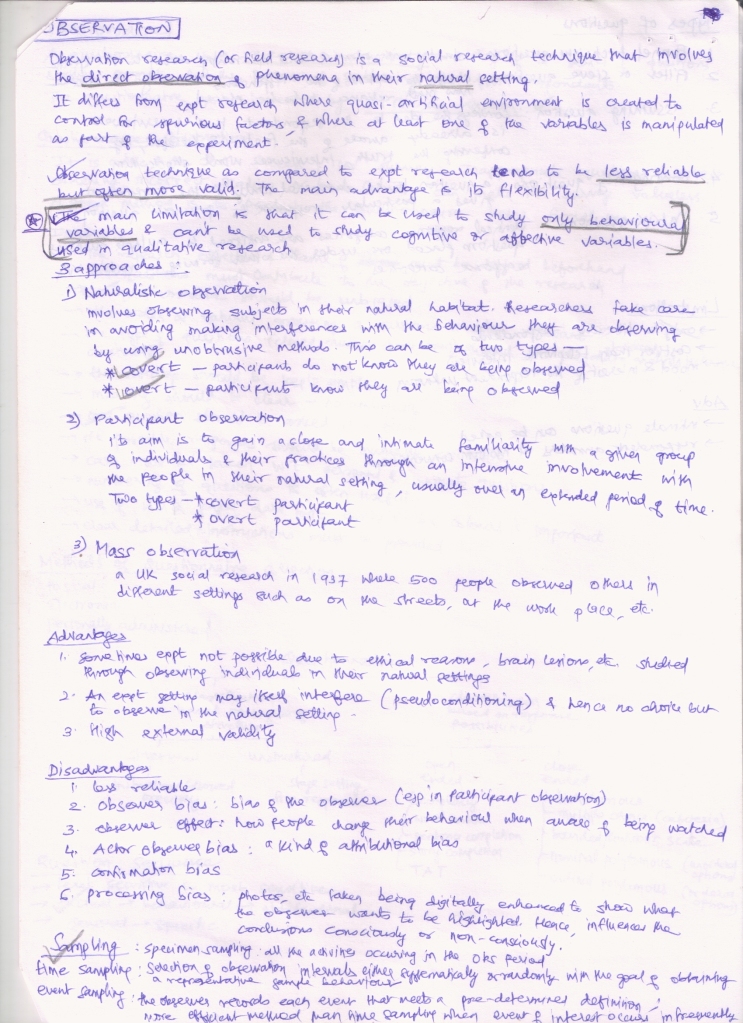

Paper 1- Chapter 3: IRT
Since IRT can be asked as a 60 marker, I prepared the basics in detail. There is no point in collecting 20 pages on it. Sometimes questions asked are very difficult to predict and attempt even when the topic has been prepared. In that case, I attempted some other question. But I didn’t go much beyond the basics. Every thing has to be balanced in the limited amount of time available for preparation.


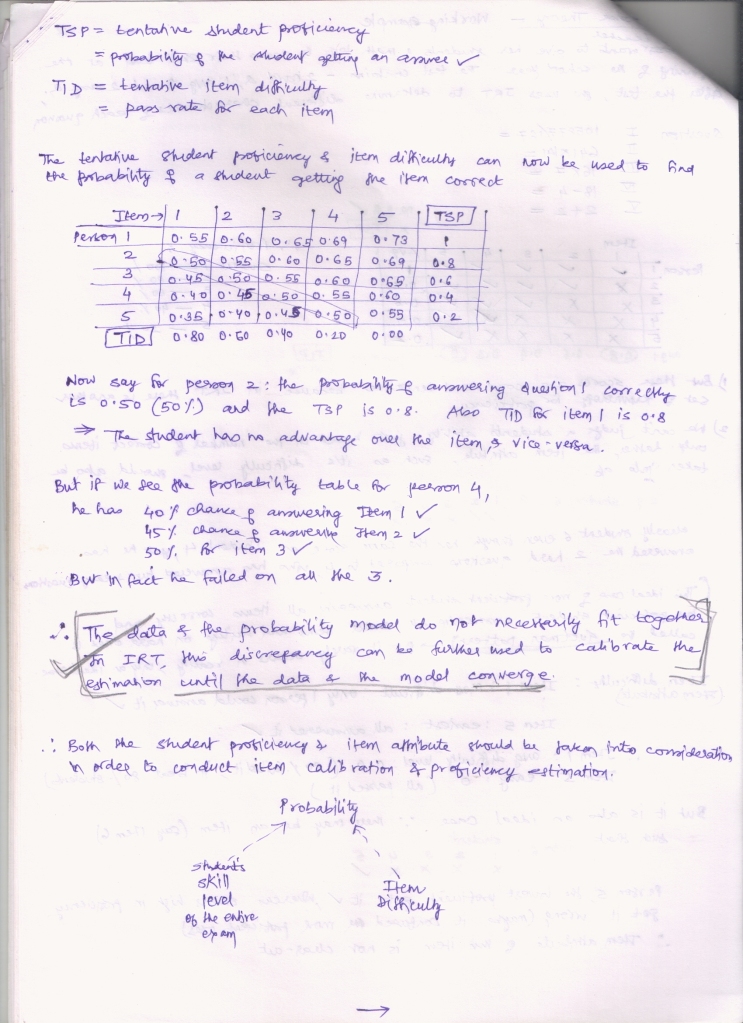
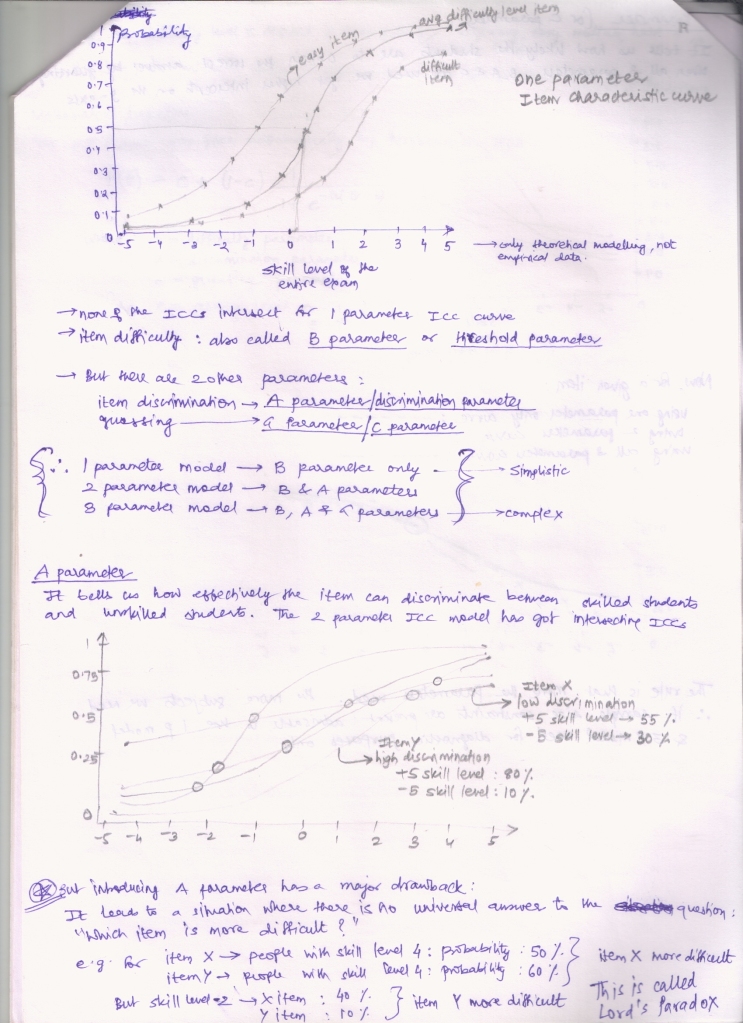
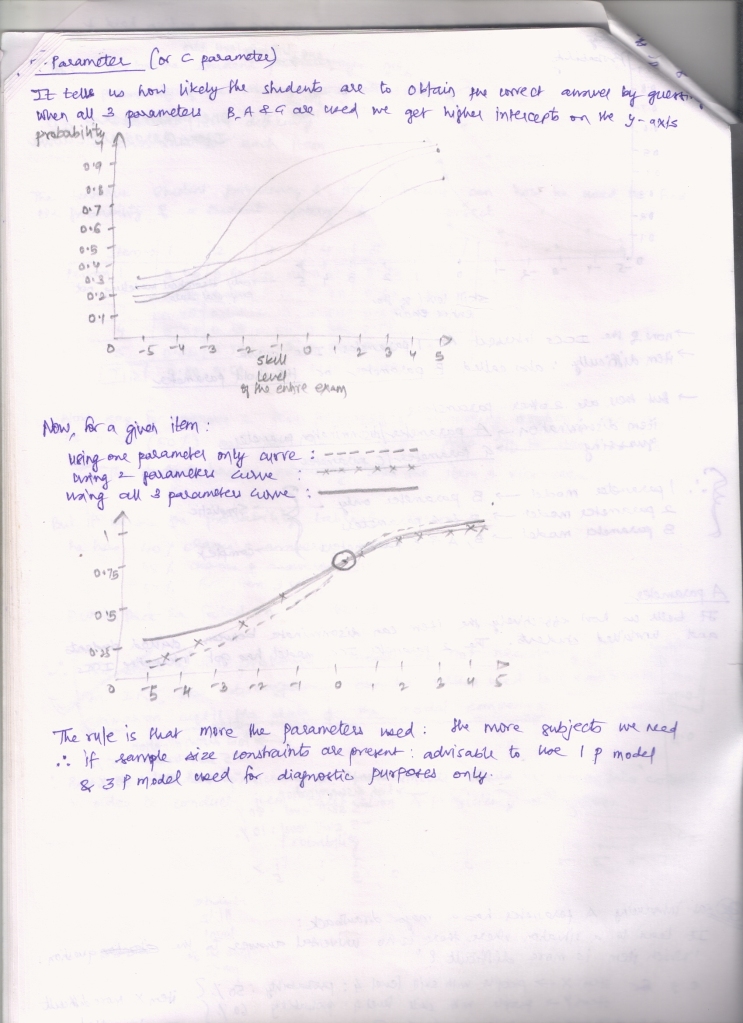

Paper 1- Chapter 4: Growth and development
It is a topic which has been very well covered in the books. So I didn’t refer any other source. I just noted each and every thing I could find in one place so as to make revision easier. A lot of time can be saved this way.
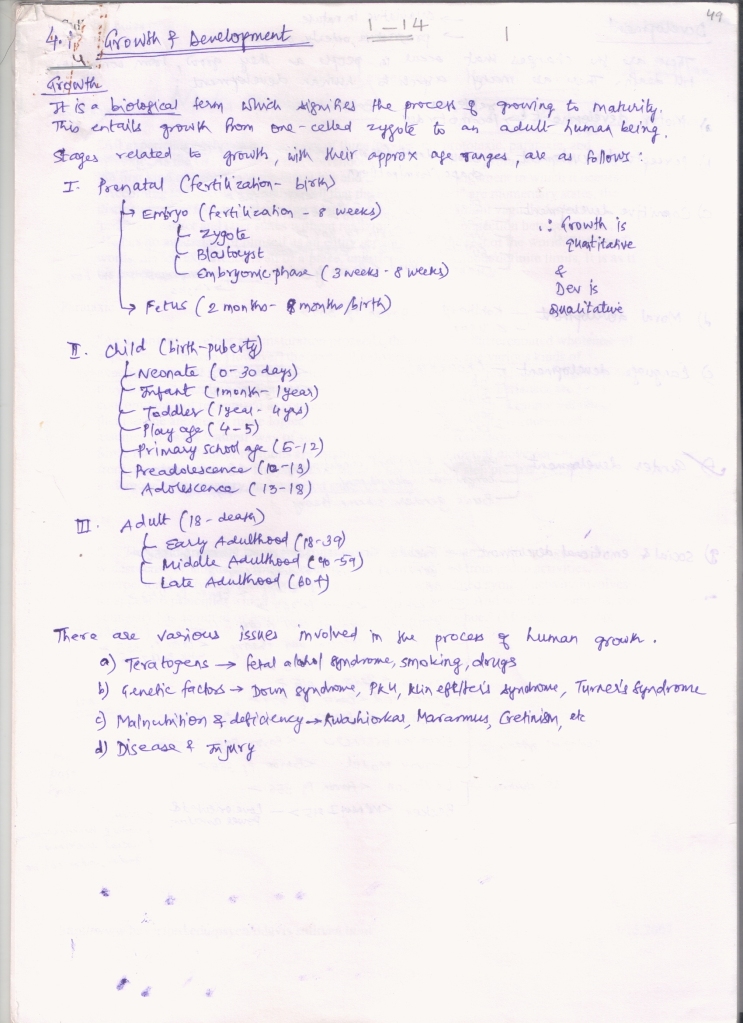
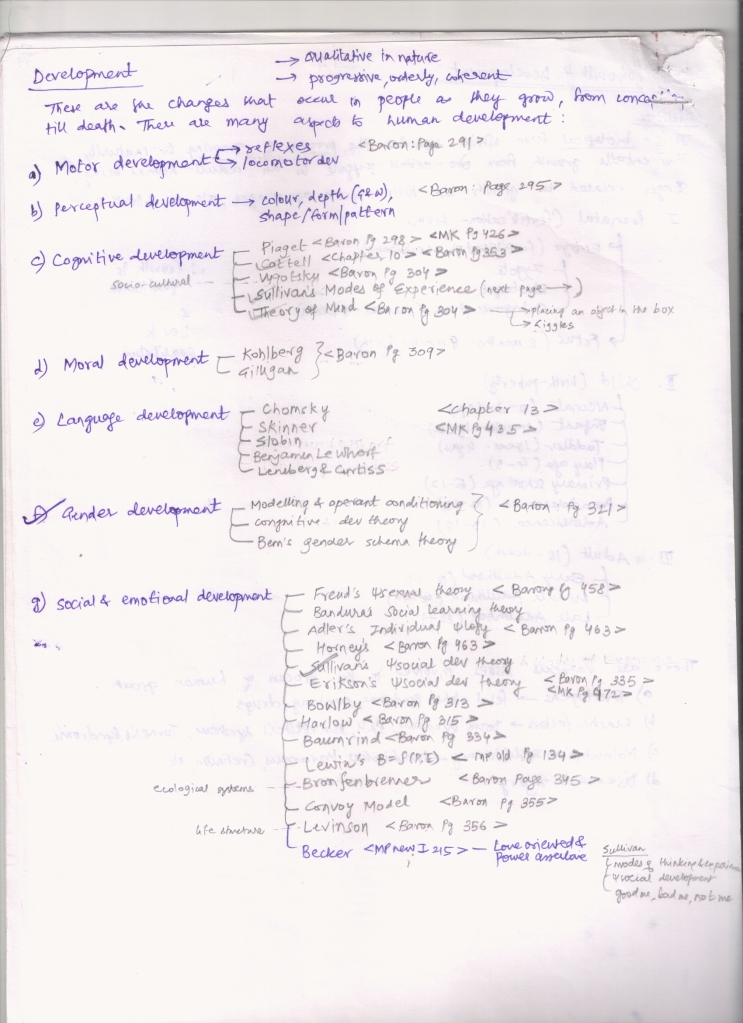
Paper 1- Chapter 5: Attention
It is well covered in Mukul Pathak sir’s notes and the models are explained very nicely in Morgan and King and other books. So I wrote everything in one place point-wise.
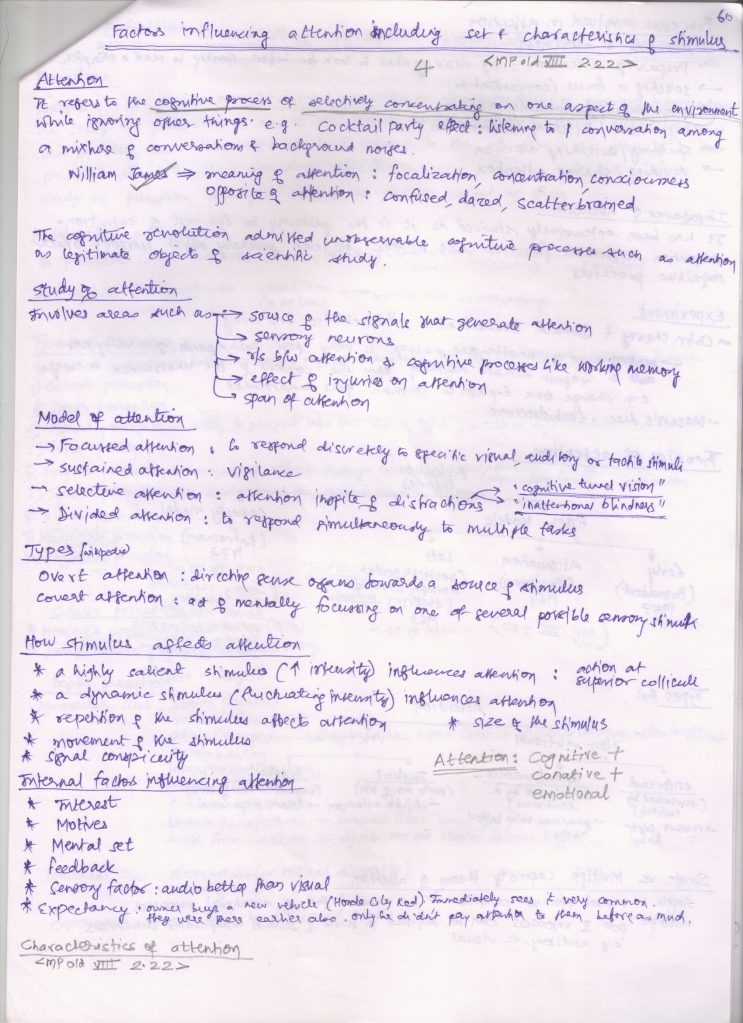

Paper 1- Chapter 12: Stereotypes and prejudices
It is an important topic not only for the psychology paper but even for other optionals such as Sociology, Essay and for GS. Since examples can be included very easily, I concentrated on collecting the keywords and theories that explain the two. This topic should be linked to other topics in both paper 1 and paper 2.


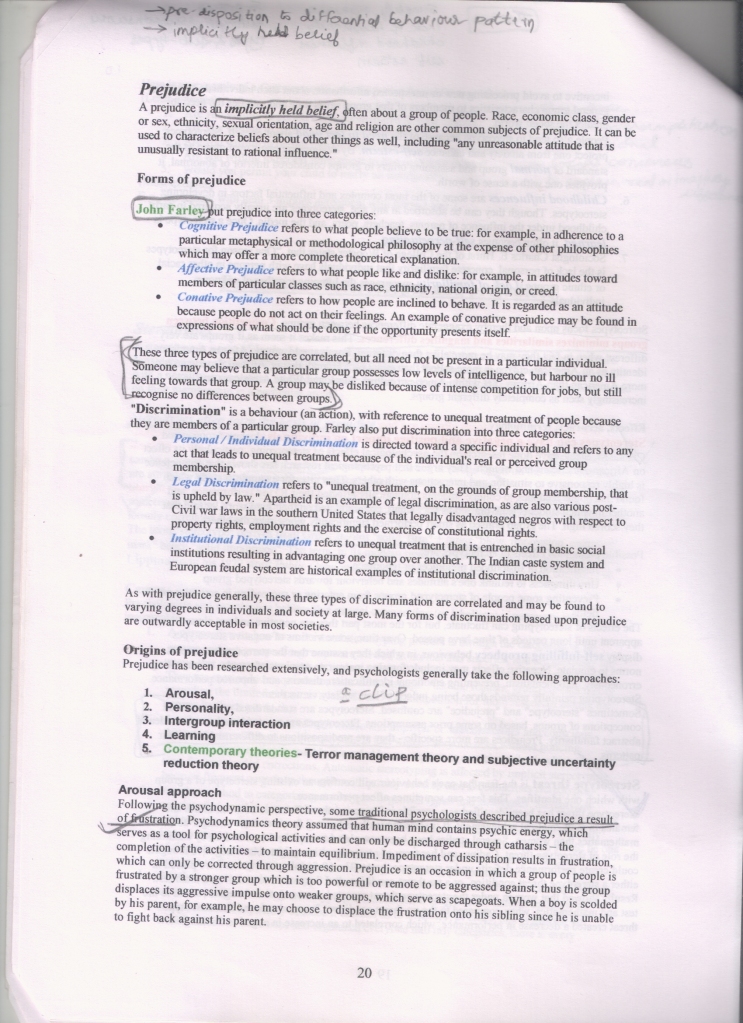
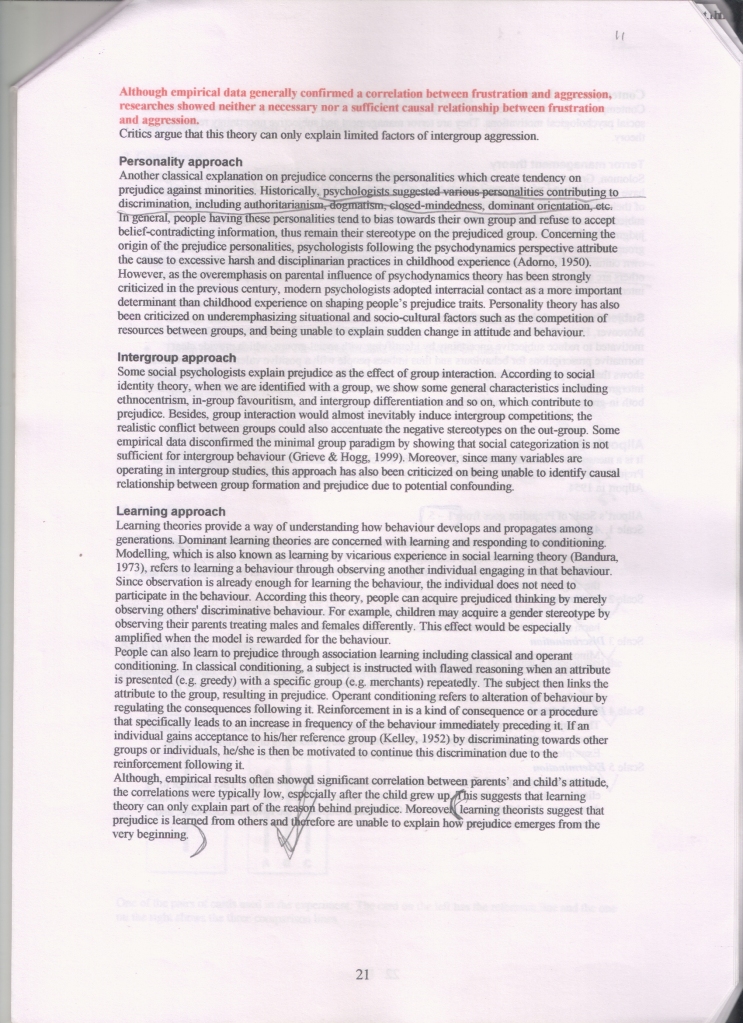
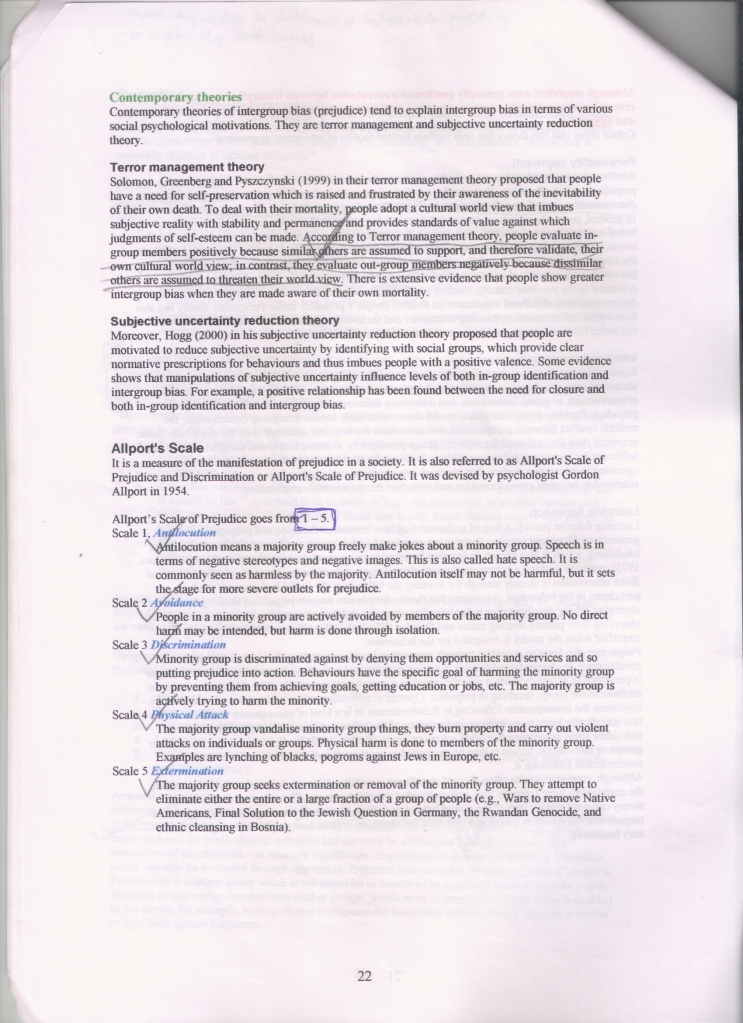
Paper 2- Chapter 7: Rehabilitation of HIV/AIDS victims
I am posting this topic because it is a classic example of those topics where a lot of material is available on the net, yet the time which might be invested in collecting data which is relevant might be much more than what you would invest if you think about the points on your own. I just collected some facts from the net.


Paper 2- Chapter 11: Government policies for promotion of entrepreneurship among youth including women entrepreneurs
Again a topic where we need to use our GS knowledge. I noted some of the schemes and institutes which I could find on the net. I added all the schemes and various bodies which are working in this field that I had come across in the India Yearbook.
I have uploaded only the 1st page. Details can easily be found on the net.

Paper 2- Chapter 13: Psychology of terrorism
I concentrated on collecting as many theories, key words and points as I could. Enough is available on the net.
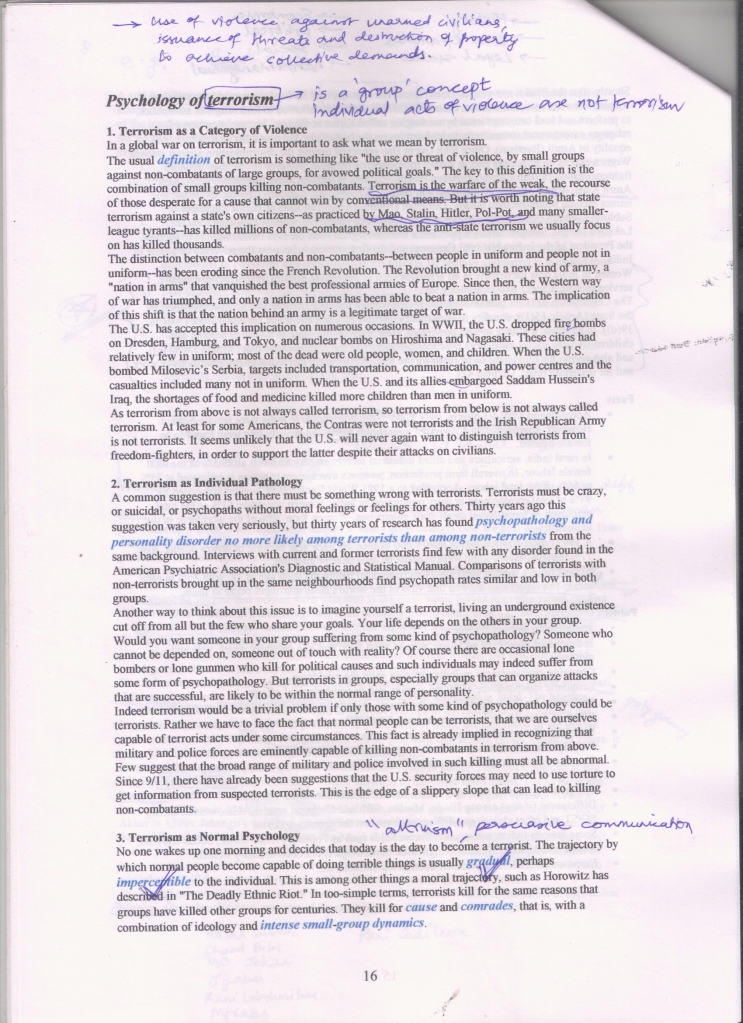

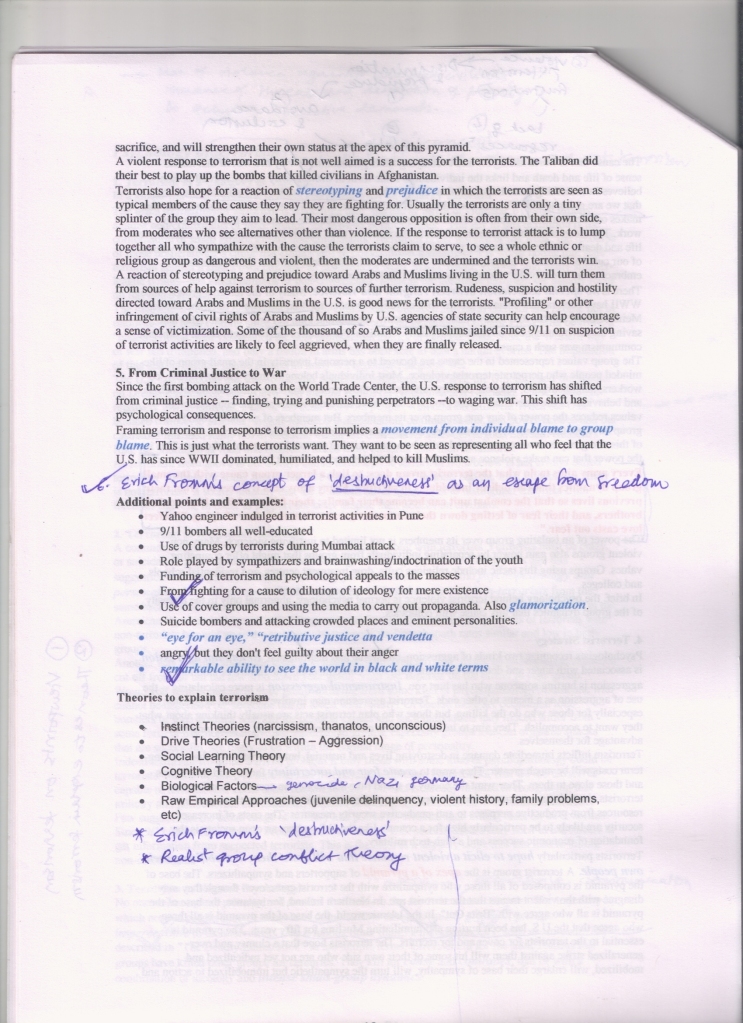
I will explain how I prepared the notes. But I repeat- this is the strategy I followed in 2009 for psychology. If what you are doing is very different, don’t worry. There are n number of ways to score. Just chalk out a plan and try your best to implement it.
MK: Morgan and King/ MP: Mukul Pathak sir’s notes/CK: Chaplin- Krawiec
Paper 1- Chapter 2: Observation
Since I prepared every topic as a 60 marker, for observation I collected 15-20 points which I could later expand in the exam. An easy way to do that is to compare the given topic with other related topics. So if observation alone comes as a 60 marker (most likely it will be in conjunction with some other topic), just link it with case studies, experimental research, interview, etc.


Paper 1- Chapter 3: IRT
Since IRT can be asked as a 60 marker, I prepared the basics in detail. There is no point in collecting 20 pages on it. Sometimes questions asked are very difficult to predict and attempt even when the topic has been prepared. In that case, I attempted some other question. But I didn’t go much beyond the basics. Every thing has to be balanced in the limited amount of time available for preparation.






Paper 1- Chapter 4: Growth and development
It is a topic which has been very well covered in the books. So I didn’t refer any other source. I just noted each and every thing I could find in one place so as to make revision easier. A lot of time can be saved this way.


Paper 1- Chapter 5: Attention
It is well covered in Mukul Pathak sir’s notes and the models are explained very nicely in Morgan and King and other books. So I wrote everything in one place point-wise.


Paper 1- Chapter 12: Stereotypes and prejudices
It is an important topic not only for the psychology paper but even for other optionals such as Sociology, Essay and for GS. Since examples can be included very easily, I concentrated on collecting the keywords and theories that explain the two. This topic should be linked to other topics in both paper 1 and paper 2.





Paper 2- Chapter 7: Rehabilitation of HIV/AIDS victims
I am posting this topic because it is a classic example of those topics where a lot of material is available on the net, yet the time which might be invested in collecting data which is relevant might be much more than what you would invest if you think about the points on your own. I just collected some facts from the net.


Paper 2- Chapter 11: Government policies for promotion of entrepreneurship among youth including women entrepreneurs
Again a topic where we need to use our GS knowledge. I noted some of the schemes and institutes which I could find on the net. I added all the schemes and various bodies which are working in this field that I had come across in the India Yearbook.
I have uploaded only the 1st page. Details can easily be found on the net.

Paper 2- Chapter 13: Psychology of terrorism
I concentrated on collecting as many theories, key words and points as I could. Enough is available on the net.



Posted by
n
at
8:26 PM
Public Admin- sample notes
I am going to try to explain how I prepared the notes. Examples, etc can either be prepared beforehand or you may come up with something then and there while writing the answer. Also, linking various topics is extremely important as it leads to a complete answer. I don’t mean topics only in Pub Ad paper 1 and Pub Ad paper 2, but also relating topics in Pub Ad paper 1 and Psychology Paper 1 OR Psychology paper 2 and GS.
PA paper 1:
I have posted the notes I prepared for Kautilya from Prasad & Prasad. Through this I attempt to achieve the following:
1. How to reduce what you have to read for the exam, in order to make it manageable to revise.
2. The content remains the same, it’s only the presentation and wording which changes depending on the question asked.
3. How you can look forward to relating the topics once your notes are ready.


So this is everything I did for topic 1 from chapter 1 of paper 2. Similarly, I prepared for Mughal Administration from Fadia and Fadia & tried to revise the 2-3 pages I had again and again so that I would be able to remember the content in the exam.
Next is a topic from paper 1, Chapter 12: Public borrowings and public debt
I covered this topic from Fadia & Fadia and searched on the net for some facts. After I was finished with enough content to write a 60 marker, I did not refer anything else. I emphasised on revising as many times as I could the content I had.
Also, I would like to point out that most of the data I collected even for paper 1 topics was that of India. I never differentiated whether the topic was mentioned in paper 1 or paper 2. Answer had to be based on India. This is what the right orientation and approach is all about, and was taught very well by Pavan sir.

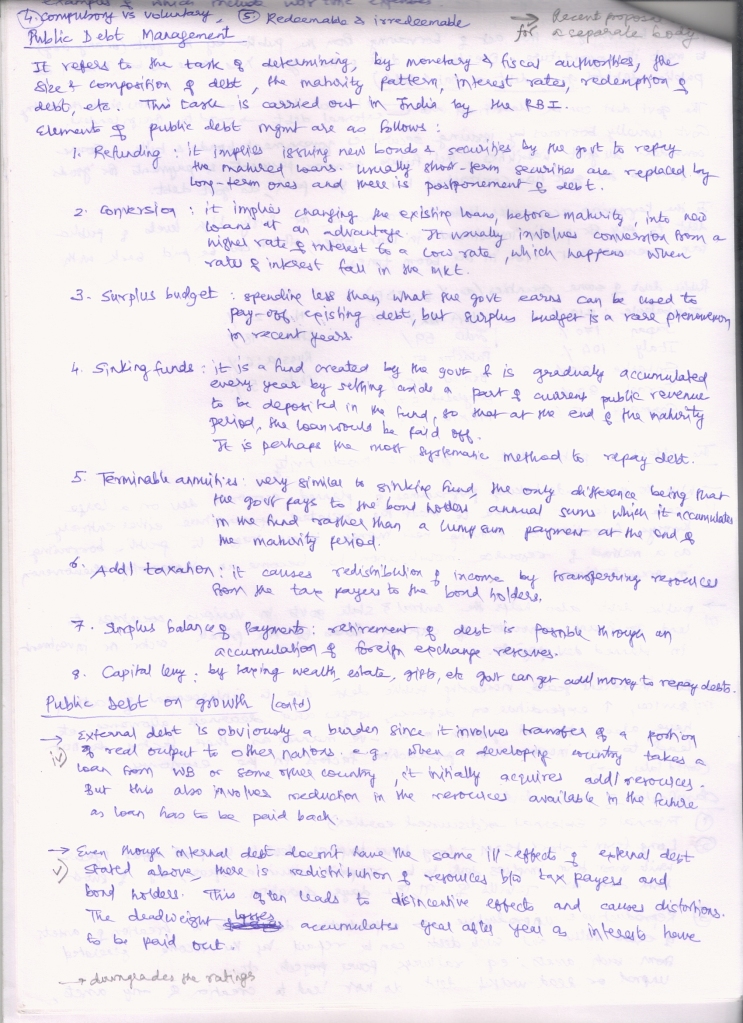
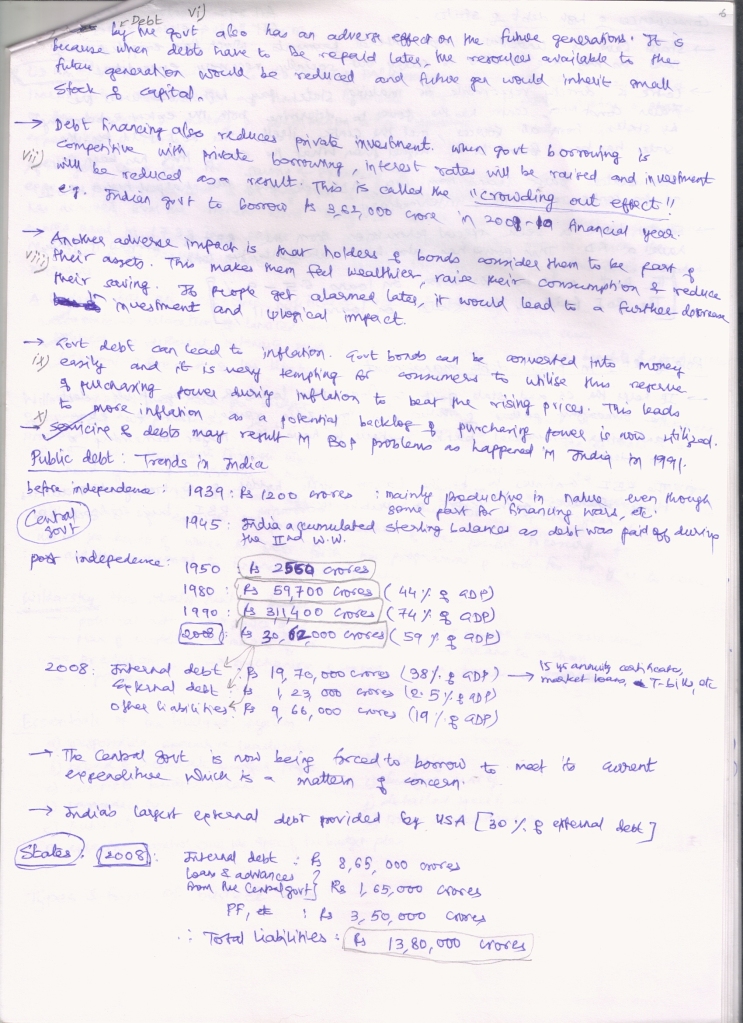

PA paper 1:
I have posted the notes I prepared for Kautilya from Prasad & Prasad. Through this I attempt to achieve the following:
1. How to reduce what you have to read for the exam, in order to make it manageable to revise.
2. The content remains the same, it’s only the presentation and wording which changes depending on the question asked.
3. How you can look forward to relating the topics once your notes are ready.


So this is everything I did for topic 1 from chapter 1 of paper 2. Similarly, I prepared for Mughal Administration from Fadia and Fadia & tried to revise the 2-3 pages I had again and again so that I would be able to remember the content in the exam.
Next is a topic from paper 1, Chapter 12: Public borrowings and public debt
I covered this topic from Fadia & Fadia and searched on the net for some facts. After I was finished with enough content to write a 60 marker, I did not refer anything else. I emphasised on revising as many times as I could the content I had.
Also, I would like to point out that most of the data I collected even for paper 1 topics was that of India. I never differentiated whether the topic was mentioned in paper 1 or paper 2. Answer had to be based on India. This is what the right orientation and approach is all about, and was taught very well by Pavan sir.




Posted by
n
at
8:23 PM
Newspaper reading
I tried to do it for The Hindu. But couldn’t do it properly at www.thehindu.com. I need either the newspaper or epaper, which isn’t available.
Anyways, it doesn’t matter much as 2 examples (ToI and ET) are enough to get an idea. Just apply the same concept to Hindu as well. I will try to get hold of an issue of the paper in the next few days and let you know.
The Economic Times, Tuesday, 29 June 2010, Delhi edition
(available on www.epaper.timesofindia.com)
Page1: Look up terms such as base rate if you don’t know. Also, the G20 article is worth reading. I wouldn’t have cut it. But it gives an idea about how negotiations involve give & take and what is the talk of the town as far as world economy is concerned.
Page 2: I would have cut the article on India- Canada civil nuclear deal. Facts such as it’s the ninth one for India, other 8 are also given, etc are important.
The article on good Taliban is worth a read as it gives a decent idea about the present situation.
Page 3: The article on Centre defending CRPF is worth a read. It gives a very balanced viewpoint on the whole issue. I wouldn’t have cut it. But certainly would have remembered government’s reply as CRPF action is totally justified and is based on logic and reasoning and not emotions.
Page 4 to 10: irrelevant
Page 11: note terms like TDS and look up on the net if you don’t know.
Smart cards for NREGA workers is worth cutting. It can be used as one of the points in answers involving use of smart cards, ways to improve efficiency and effectiveness of government schemes, etc.
The article on FATF is important…know what FATF is…what is money laundering and PMLA…i would have cut the article…
Mahatma Gandhi Institute of Education for Peace and Sustainable Development is worth cutting. Government is funding it.
Page 12: A very good article on malnutrition that I would have definitely cut. This is why ET is very good. As most of the edits are written by serving/retired govt servants, it results in a very balanced and fact-based article. NFHS data, correlation between land productivity, women’s education and other factors such as sanitation, safe drinking water, good governance with malnutrition is definitely worth noting. Data on anaemic children and women, protein deficiency among Indians, etc is important.
Other articles which are good but I wouldn’t have cut them: the one on mobile tech, look up terms such as 3G, CDMA, LTE, BWA, Wi-Max, etc on the net.
As I have said many times, my S&T prep was from the newspapers only.
Article on structural reform is worth a read. Look up what structural reforms mean, what is Keynesian economics, stimulus, etc.
Page 13: I would have cut the article ‘Environmental governance & a new authority’ as it gives good info on the proposed NEPA, but noting that nothing concrete has happened as of now.
The article ‘Right climate for energy peg’ is worth a read. It conveys the problem of balancing development and protecting the environment at the same time.
But I wouldn’t have cut it as it is short on facts.
From the article on aggro business, look up FCI, NCDEX, MCX, if you don’t know.
Pages 14 and 15: irrelevant. But look up BIS if you don’t know what it is.
Page 16: Terms like ULIPs, teaser rates, etc should be known.
Even though today’s ET in the classroom on CTS is not that relevant, but it is one of the few columns I always looked forward to reading. Gives very good info most often.
Pages 17 to 23: irrelevant.
Page 24: ‘Abolish death sentence’: it is a typical Hindu-like article. Strongly opinionated. Yet, I would have noted how many countries have abolished death sentence, how many have retained it, number of executions that have taken place in 2008 and 09, etc. No need to remember what Amnesty International says. But yes, cost factor when not abolished and on the other hand using captured terrorists for better understanding of their psyche, etc are good points to write in an answer on capital punishment.
I hope it was helpful in getting an idea of how to read the newspapers. I will look into Hindu in a couple of days.
earlier:
The Times of India- Thursday, 24th June, Delhi edition
(available on www.epaper.timesofindia.com)
I will point out the relevant articles and reasons why I would/wouldn’t cut some of the articles.
Page 1:
Cabinet decision on rupee…it’s relevant but it hasn’t been decided yet. I would still cut it as it talks about the whole procedure of selecting the symbol which may not be described again later.
For those with pub ad, the matter of absentee cabinet ministers is worth cutting. In the exam, do not take names in this matter. Just write, some ministers have been absent…it’s alarming as political factors are playing more important role than governance…
In the news digest, the only one relevant and to look forward to is the Canadian PM’s apology on Kanishka…you should know what the matter was and who is the Canadian PM.
Honour killing issue not worth cutting as you are not going to write specific names/incidents in the GS paper. It is a wider issue which needs to be known in its entirety.
Page 3: irrelevant
Page 4: irrelevant
Page 5: irrelevant
Page 6: irrelevant
Page 7: irrelevant
Even though city section rarely has news relevant for the exam, yet I glance through it as sometimes it might have some important news.
Page 8: irrelevant.
Page 9: irrelevant
Page 10: irrelevant
So, 10 pages take around 15 minutes. With practice you would be able to decide whether an article is relevant or not by just reading the heading or 2-3 lines at most.
Page 11: irrelevant
Page 12: You should know what super 30 is…also coz this year the PM invited the teacher for a meeting. No need to read the whole article. Also, the only line I found relevant was “the Internet has grown the fastest in this world. It took 38 years for radio to reach the people, 13 years for television and just 4 years for the Internet.”
Finished the page in less than 5 minutes.
Page 13: irrelevant
Page 14:
Loharinag Pala is important. May be asked for 2 marks.
Kanishka is important. If you don’t know what it was, definitely cut the article.
Page 15: irrelevant
Page 16: The article on China’s support to Pakistan on nuclear plants is important if you haven’t cut an article on this before. This can be used in China-Pak r/s. I would have definitely used it in China’s peaceful rise doctrine had it happened last year.
China’s pudina patent also important. Also, remember terms like bio-piracy and TKDL.
Page 17: For those with pub ad, Karnataka’s Lokayukta resigning is important. Do not take names. Just write recently Lokayukta of Karnataka resigned…giving reasons.
Also, CVC request for tackling corruption important. It’s a government body. So CVC recommendation can be written in the exam straightaway.
Page 18: only the article on Tamil conference is important. But it’s not worth cutting. You should cut some article which presents the facts and not what TN CM has to say. Where the conference is being held, what is a classical language? Which all languages in India have been declared as classical languages, etc should be known.
Page 20:
The only relevant article and a very good one is that by Prakash Singh on Maoists. He has presented some new points such as security forces themselves being one of the biggest arms- providers to the Maoists (as they attack and decamp with weapons). The solutions he provides, local police: CPF ratio, etc and also terms such as ‘irregular war’ are important.
Rest of the articles aren’t good. Indo-Pak is the usual blah blah, nothing new. Honour killings one is just opinion based. No tangible info.
Page 21: only relevant one is the article on LHC. I wouldn’t cut it. Only look up LHC, ‘god particle’(Higgs boson), etc on wikipedia. This was my standard preparation for science and tech.
Page 22: Only know 2 lines about who Nikki Haley is. If she wins, it might be asked (even though probability is low). But if she loses, forget about her. But there is definitely no need of cutting the article.
Page 23: irrelevant.
Page 25: just note down terms like HNI, MF, ULIP, etc if you don’t know them. The article on HNI is useless. In fact, the article today (Sunday, 27th June) on the increasing concentration of wealth in India is very good, which actually uses the same data.
Page 26: irrelevant
Pages 27 to 30: irrelevant
Page 31: Just know why John Isner and Nicolas Mahut were in the news. But I think probability of being asked in the Mains is very low.
Page 32: Just know Clean Sports India movement. But again, very low probability of being asked.
So, with some practice, it would take 30-35 minutes to finish this issue.
Do ask me questions. If you feel some article I left out was relevant or an article I chose was irrelevant, kindly let me know.
Anyways, it doesn’t matter much as 2 examples (ToI and ET) are enough to get an idea. Just apply the same concept to Hindu as well. I will try to get hold of an issue of the paper in the next few days and let you know.
The Economic Times, Tuesday, 29 June 2010, Delhi edition
(available on www.epaper.timesofindia.com)
Page1: Look up terms such as base rate if you don’t know. Also, the G20 article is worth reading. I wouldn’t have cut it. But it gives an idea about how negotiations involve give & take and what is the talk of the town as far as world economy is concerned.
Page 2: I would have cut the article on India- Canada civil nuclear deal. Facts such as it’s the ninth one for India, other 8 are also given, etc are important.
The article on good Taliban is worth a read as it gives a decent idea about the present situation.
Page 3: The article on Centre defending CRPF is worth a read. It gives a very balanced viewpoint on the whole issue. I wouldn’t have cut it. But certainly would have remembered government’s reply as CRPF action is totally justified and is based on logic and reasoning and not emotions.
Page 4 to 10: irrelevant
Page 11: note terms like TDS and look up on the net if you don’t know.
Smart cards for NREGA workers is worth cutting. It can be used as one of the points in answers involving use of smart cards, ways to improve efficiency and effectiveness of government schemes, etc.
The article on FATF is important…know what FATF is…what is money laundering and PMLA…i would have cut the article…
Mahatma Gandhi Institute of Education for Peace and Sustainable Development is worth cutting. Government is funding it.
Page 12: A very good article on malnutrition that I would have definitely cut. This is why ET is very good. As most of the edits are written by serving/retired govt servants, it results in a very balanced and fact-based article. NFHS data, correlation between land productivity, women’s education and other factors such as sanitation, safe drinking water, good governance with malnutrition is definitely worth noting. Data on anaemic children and women, protein deficiency among Indians, etc is important.
Other articles which are good but I wouldn’t have cut them: the one on mobile tech, look up terms such as 3G, CDMA, LTE, BWA, Wi-Max, etc on the net.
As I have said many times, my S&T prep was from the newspapers only.
Article on structural reform is worth a read. Look up what structural reforms mean, what is Keynesian economics, stimulus, etc.
Page 13: I would have cut the article ‘Environmental governance & a new authority’ as it gives good info on the proposed NEPA, but noting that nothing concrete has happened as of now.
The article ‘Right climate for energy peg’ is worth a read. It conveys the problem of balancing development and protecting the environment at the same time.
But I wouldn’t have cut it as it is short on facts.
From the article on aggro business, look up FCI, NCDEX, MCX, if you don’t know.
Pages 14 and 15: irrelevant. But look up BIS if you don’t know what it is.
Page 16: Terms like ULIPs, teaser rates, etc should be known.
Even though today’s ET in the classroom on CTS is not that relevant, but it is one of the few columns I always looked forward to reading. Gives very good info most often.
Pages 17 to 23: irrelevant.
Page 24: ‘Abolish death sentence’: it is a typical Hindu-like article. Strongly opinionated. Yet, I would have noted how many countries have abolished death sentence, how many have retained it, number of executions that have taken place in 2008 and 09, etc. No need to remember what Amnesty International says. But yes, cost factor when not abolished and on the other hand using captured terrorists for better understanding of their psyche, etc are good points to write in an answer on capital punishment.
I hope it was helpful in getting an idea of how to read the newspapers. I will look into Hindu in a couple of days.
earlier:
The Times of India- Thursday, 24th June, Delhi edition
(available on www.epaper.timesofindia.com)
I will point out the relevant articles and reasons why I would/wouldn’t cut some of the articles.
Page 1:
Cabinet decision on rupee…it’s relevant but it hasn’t been decided yet. I would still cut it as it talks about the whole procedure of selecting the symbol which may not be described again later.
For those with pub ad, the matter of absentee cabinet ministers is worth cutting. In the exam, do not take names in this matter. Just write, some ministers have been absent…it’s alarming as political factors are playing more important role than governance…
In the news digest, the only one relevant and to look forward to is the Canadian PM’s apology on Kanishka…you should know what the matter was and who is the Canadian PM.
Honour killing issue not worth cutting as you are not going to write specific names/incidents in the GS paper. It is a wider issue which needs to be known in its entirety.
Page 3: irrelevant
Page 4: irrelevant
Page 5: irrelevant
Page 6: irrelevant
Page 7: irrelevant
Even though city section rarely has news relevant for the exam, yet I glance through it as sometimes it might have some important news.
Page 8: irrelevant.
Page 9: irrelevant
Page 10: irrelevant
So, 10 pages take around 15 minutes. With practice you would be able to decide whether an article is relevant or not by just reading the heading or 2-3 lines at most.
Page 11: irrelevant
Page 12: You should know what super 30 is…also coz this year the PM invited the teacher for a meeting. No need to read the whole article. Also, the only line I found relevant was “the Internet has grown the fastest in this world. It took 38 years for radio to reach the people, 13 years for television and just 4 years for the Internet.”
Finished the page in less than 5 minutes.
Page 13: irrelevant
Page 14:
Loharinag Pala is important. May be asked for 2 marks.
Kanishka is important. If you don’t know what it was, definitely cut the article.
Page 15: irrelevant
Page 16: The article on China’s support to Pakistan on nuclear plants is important if you haven’t cut an article on this before. This can be used in China-Pak r/s. I would have definitely used it in China’s peaceful rise doctrine had it happened last year.
China’s pudina patent also important. Also, remember terms like bio-piracy and TKDL.
Page 17: For those with pub ad, Karnataka’s Lokayukta resigning is important. Do not take names. Just write recently Lokayukta of Karnataka resigned…giving reasons.
Also, CVC request for tackling corruption important. It’s a government body. So CVC recommendation can be written in the exam straightaway.
Page 18: only the article on Tamil conference is important. But it’s not worth cutting. You should cut some article which presents the facts and not what TN CM has to say. Where the conference is being held, what is a classical language? Which all languages in India have been declared as classical languages, etc should be known.
Page 20:
The only relevant article and a very good one is that by Prakash Singh on Maoists. He has presented some new points such as security forces themselves being one of the biggest arms- providers to the Maoists (as they attack and decamp with weapons). The solutions he provides, local police: CPF ratio, etc and also terms such as ‘irregular war’ are important.
Rest of the articles aren’t good. Indo-Pak is the usual blah blah, nothing new. Honour killings one is just opinion based. No tangible info.
Page 21: only relevant one is the article on LHC. I wouldn’t cut it. Only look up LHC, ‘god particle’(Higgs boson), etc on wikipedia. This was my standard preparation for science and tech.
Page 22: Only know 2 lines about who Nikki Haley is. If she wins, it might be asked (even though probability is low). But if she loses, forget about her. But there is definitely no need of cutting the article.
Page 23: irrelevant.
Page 25: just note down terms like HNI, MF, ULIP, etc if you don’t know them. The article on HNI is useless. In fact, the article today (Sunday, 27th June) on the increasing concentration of wealth in India is very good, which actually uses the same data.
Page 26: irrelevant
Pages 27 to 30: irrelevant
Page 31: Just know why John Isner and Nicolas Mahut were in the news. But I think probability of being asked in the Mains is very low.
Page 32: Just know Clean Sports India movement. But again, very low probability of being asked.
So, with some practice, it would take 30-35 minutes to finish this issue.
Do ask me questions. If you feel some article I left out was relevant or an article I chose was irrelevant, kindly let me know.
Tips on covering the books
I would like to point out a few things before I start. Firstly, as I have always said, it’s better to read one book 5 times rather than reading 5 books once. Whichever book you have selected on a particular subject, keep reading it again and again till you are so thorough that you can point out what is given where.
The tips which I am suggesting here are entirely based on the way I read a particular book. Your style of reading/studying might be very different. So if you have already adopted a strategy, and it is different from mine, kindly ignore what I have to say. The only goal is to complete the book and revise it, whichever method it might be.
The books I am covering here are the ones I have suggested in my earlier posts. They are:
The first time I attempted to read this book, I could reach only the 70th page before I surrendered. In my opinion, those who do not have the HABIT of reading books (and I am one of them), will find it very difficult to cover it in one go. So the method was to concentrate on one chapter at a time and adopt a strategy to not only understand but gain an insight as to why the events described happened.
After reading 1 or 2 pages at a time, I thought of the questions which might be asked if the examiner happened to focus on those 2 pages. I made a notebook in which I covered this book chapter-wise. I wrote all the questions from a particular chapter I could think of. This way on an average I made 7-8 questions from each chapter.
For example, when I was reading the chapter on Non-cooperation movement, few incidents were described which forced the launch of NCM. Then the incidents during the movement were described and why it was finally called off. The reaction of various leaders and parties was also covered in the book. So I made 3-4 questions from it such as:
Q. Describe the events which led to the launch of NCM.
Q. How was the NCM different from earlier movements?
Q. Why was NCM called off and what was the reaction to Mahatma Gandhi’s decision?
Q. What was the impact of NCM on Indian National Movement?
This way I could link all the different aspects of NCM and every other movement/ incident. This helps in not only gaining an insight but also remembering the points to write in the exam so as to present a complete answer.
After I finished all the chapters (left one or two in the middle which I found were too specific and hence not useful), I had with me around 230 questions. I went through the previous 10 years’ question papers and was happy to find that not even a single question was asked on INM which was not there in my notebook.
The other thing which I did was to note the name of the persons I came across while reading the book, on the last page of my notebook. So if Indulal Yagnik was mentioned on, say page x and again 300 pages later on page y, I noted it down as Indulal Yagnik (x,y…). This way I could remember everything about the person mentioned in the book as well as relate the events in which the said person was involved.
Whether you finish the book in one go or read it in between other things entirely depends on you. The aim should be to cover it well before the exams and be able to revise the questions you made.
But keep in mind that you should not concentrate only on making the questions. Question-making is only to help you remember the content and relate the events. Concentrate on the content and when you have finished reading all the things which were related directly to each other, then only think of the questions. As I said, I made only 230 or so questions, which makes it 1 question/ 3 pages approximately.
DD Basu’s Constitutional Law of India
I must have read this book at least 10 times during my 3 attempts. It is one of the best books I have come across and certainly THE base book for the Civil Services exam, especially when you have public administration as an optional.
There is no need to remember each and everything given in the book and neither do we have to remember the Articles verbatim.
Instead, focus on the outline of an Article and only in the case of important Articles do we need to remember the details. Important Articles would be FRs, DPSPs, election of the President, CoM, office of profit, budget, CAG, EC, UPSC, FC, emergencies, etc
There are 2 versions of DD Basu available. I had the detailed one. There is another one which is concise. Either will do. But I covered the Articles Part-wise, i.e. Article 1, 2, 3…and so on.
Firstly, I mugged up the Parts of the Constitution. The Constitution is divided into 22 Parts. Remembering the Parts helps in recalling the Articles quickly. So I remembered that Part III is FRs (Articles 12 to 35), Part V is The Union (Articles 52 to 151), Part XVIII is Emergency Provisions (Articles 352 to 360), etc
Then I started with the Articles. I covered 20 Articles at a time and continued revising them till I was able to recall all 20 without looking in the book. Then went ahead and after I had finished first 50 Articles, tried to recall all 50 in one go. Then first 100 and so on.
As I said, no need to remember the Articles verbatim. You need to know that Article 72 is regarding the power of the President to grant pardons and roughly in what kind of cases, i.e. court-martials, death sentences and cases to which the executive power of the Union extends.
This way I remembered around 400 of the 440 or so Articles in the Constitution and left the ones I considered not important, especially the ones in the end.
Shortcut: One of them is that many Articles of the Union correspond to Articles of the States. So from Article 72 onwards add 89 to get the corresponding Article at the State level. Keep doing it till Article 111. Article 201 is extra which relates to the President’s powers when a Bill has been reserved for his consideration by the Governor under Article 200. So after this, from Article 112 onwards add 90 to get the corresponding Article at the State level.
I concentrated on the Constitution as many of the questions can be answered through the Articles in the Constitution by directly quoting the Articles in the introduction part of the answer.
No need to go too deeply into the explanations provided in the book. Just read them for understanding what the Article is about. Thereafter, you can leave it out when you revise. Also, there’s no need to remember all the cases relating to various Articles. Only very important ones such as Golak Nath, Keshvananda Bharti, Minerva Mills, etc and the recent IR Coelho, TMA Pai, PA Inamdar, etc need to be remembered.
Also, only the important Amendments such as 42nd, 44th, 86th, etc and the recent ones 91st, 92nd, 93rd and 94th need to be remembered.
For more on the Constitution, refer http://indiacode.nic.in/coiweb/welcome.html
Statistics by Spectrum
One of the biggest mistakes which many commit is merely “reading” the questions in the book and not practising the statistics questions by attempting them in an exam-like situation.
I remember in XI standard when we had vectors. I just read the questions in R D Sharma and they appeared to be very easy. However, in the test when I attempted the questions, I couldn’t even go beyond the 1st step. Same is the case with statistics. If you think questions are very easy, most often than not, when you attempt the questions in an exam-like situation, serious doubts are going to emerge.
Keeping the above point in mind, covering the book on statistics by spectrum is more than enough. Statistics was my strength in the 2nd paper and therefore, first analyze your ability, and then try to execute your plan.
The basic thing to remember is that 80% of the questions asked in a particular year are repeated ones. They might change the numbers, etc but the graph/diagram more or less remains the same.
Statistics in 2009 was the easiest compared to 2007 and 2008 (2008 was the toughest according to me), and the only thing to guard against was the time factor as the graphs and questions were very simple, but at the same time, very lengthy. In such situations, always take a scale such that the bars will be small and shading, etc should be done freehand.
The method which I adopted to cover spectrum was based on the decision that I would practice/ go through statistics thrice-
I went through the basics given in spectrum, such as the definitions, different types of bar diagrams, area diagrams, ogives, tables, etc. Thereafter, I went through the sample questions and made it a point that I would READ 2 questions and SOLVE the 3rd question. Always solve the question in an exam-like situation, with pencil, scale, graph paper, etc.
I applied the same rule to all the previous years’ question papers given in the book. Every year, 1 or 2 questions are asked which are different from previous years. I noted such questions on the front page of the book, as page 97- q 6…and so on…
At the end of this exercise, I had a list of around 100 questions which I would again read/solve in October along with revising the basics.
October:
I went through the basics again and went through the 100 questions which I had identified as “different” from previous years’ papers. I again applied the rule of READING 2 questions and SOLVING the 3rd one. At this point of time, I was comfortable with most of the questions and formulae and ticked the questions which I felt I should revise again just before the exam. So I shortened the revision list to about 30 questions.
October 23rd:
During the time between the 2 papers, I revised the basics in 10 minutes (I had written all the different types of graphs/diagrams and formulae on a paper) and READ the 30 questions from my list. This way I went into the exam-hall in the statistics “frame of mind” and attempted the questions straightaway.
This is one of the reasons why I said earlier in the importance of mains post that howsoever the earlier papers go: good or bad, always concentrate on the next paper and prepare yourself for it.
India Yearbook, Min of I&B, GoI
Before I begin, I would like to point out that this book should be read thoroughly only for the prelims. For the mains, only government programmes and few chapters need to be covered.
So if you are taking the prelims in 2011, go through the whole book. But if you are going to take the Mains in 2010, no need to cover the whole book at present.
For prelims
GS prelims in 2008 and 2009 had many questions directly asked from the India Yearbook. The only issue was that any line from any page was turned into a question. So a true or false statement such as salt water crocodiles are found in Andaman and Nicobar islands was from the 1st chapter Land and the People (under Fauna).
Therefore, I covered all the chapters in the book except the one on States and UTs (Chapter 30 in 2010 Yearbook).
I put a lot of emphasis on making notes as it is very difficult to cover a 1000 page book in 3-4 days in the last month or week before the exam. Moreover, 99% (or even more than that) of the India Yearbook remains the same year after year.
So I went through the India Yearbook 2009 and reduced it to 1/10th of its size by making notes. Special attention needs to be given to the following things:
If you already read the IYB for prelims, just go through what you underlined and revise your notes. But if you did not, then apart from the GOVERNMENT SCHEMES and agricultural data, read the following chapters from IYB 2010:
Chapters 1, 2, 3, 5, 7, 10, 11 (NCES only), 13 (terms like FIPB, FCCB, ECB, ADR/GDR, FDI, etc), 18, 24, 25 and 28.
Note: I have not specified chapters 16, 17, etc as I have assumed that you must have covered all the government schemes such as NRHM, JNNURM, etc irrespective of where they are given in the book.
In Mains 2009 many questions could be answered on the basis of information provided in the IYB, e.g. significance of coastal regions, UMPPs, BSUP, fruit production in India and NNRMS.
But if you don’t have time, newspapers should be preferred over standard books such as the IYB.
Civil Services Chronicle (magazine)
Since I read the Civil Services Chronicle, I am going to give some tips on how to go about it. If you read some other magazine, not a problem. You may apply the same strategy if you want to.
Regarding CSC, it’s important because newspapers are not Civil Services exam oriented. So they are bound to miss a few things which may be important for the exam. Also, it is sometimes possible that you might miss out on an important development, such as an appointment, etc. So reading CSC (or any 1 exam oriented magazine) is beneficial.
I always aimed at finishing the chronicle in a day or two (apart from newspaper reading on that day). If you find it time-consuming, always keep in mind that 3 days is the maximum time you should be spending to go through an issue.
My strategy to go through CSC was as follows:
Economic Survey
You should aim at finishing the Economic Survey in 4 days (apart from newspaper reading on those days). Only 10-15% of it is useful for the exam.
The tips which I am suggesting here are entirely based on the way I read a particular book. Your style of reading/studying might be very different. So if you have already adopted a strategy, and it is different from mine, kindly ignore what I have to say. The only goal is to complete the book and revise it, whichever method it might be.
The books I am covering here are the ones I have suggested in my earlier posts. They are:
- Bipin Chandra’s India’s Struggle for Independence
- DD Basu’s Constitutional Law of India
- Statistics by Spectrum
- India Yearbook, Min of I&B, GoI
- Civil Services Chronicle (magazine)
- Economic Survey
The first time I attempted to read this book, I could reach only the 70th page before I surrendered. In my opinion, those who do not have the HABIT of reading books (and I am one of them), will find it very difficult to cover it in one go. So the method was to concentrate on one chapter at a time and adopt a strategy to not only understand but gain an insight as to why the events described happened.
After reading 1 or 2 pages at a time, I thought of the questions which might be asked if the examiner happened to focus on those 2 pages. I made a notebook in which I covered this book chapter-wise. I wrote all the questions from a particular chapter I could think of. This way on an average I made 7-8 questions from each chapter.
For example, when I was reading the chapter on Non-cooperation movement, few incidents were described which forced the launch of NCM. Then the incidents during the movement were described and why it was finally called off. The reaction of various leaders and parties was also covered in the book. So I made 3-4 questions from it such as:
Q. Describe the events which led to the launch of NCM.
Q. How was the NCM different from earlier movements?
Q. Why was NCM called off and what was the reaction to Mahatma Gandhi’s decision?
Q. What was the impact of NCM on Indian National Movement?
This way I could link all the different aspects of NCM and every other movement/ incident. This helps in not only gaining an insight but also remembering the points to write in the exam so as to present a complete answer.
After I finished all the chapters (left one or two in the middle which I found were too specific and hence not useful), I had with me around 230 questions. I went through the previous 10 years’ question papers and was happy to find that not even a single question was asked on INM which was not there in my notebook.
The other thing which I did was to note the name of the persons I came across while reading the book, on the last page of my notebook. So if Indulal Yagnik was mentioned on, say page x and again 300 pages later on page y, I noted it down as Indulal Yagnik (x,y…). This way I could remember everything about the person mentioned in the book as well as relate the events in which the said person was involved.
Whether you finish the book in one go or read it in between other things entirely depends on you. The aim should be to cover it well before the exams and be able to revise the questions you made.
But keep in mind that you should not concentrate only on making the questions. Question-making is only to help you remember the content and relate the events. Concentrate on the content and when you have finished reading all the things which were related directly to each other, then only think of the questions. As I said, I made only 230 or so questions, which makes it 1 question/ 3 pages approximately.
DD Basu’s Constitutional Law of India
I must have read this book at least 10 times during my 3 attempts. It is one of the best books I have come across and certainly THE base book for the Civil Services exam, especially when you have public administration as an optional.
There is no need to remember each and everything given in the book and neither do we have to remember the Articles verbatim.
Instead, focus on the outline of an Article and only in the case of important Articles do we need to remember the details. Important Articles would be FRs, DPSPs, election of the President, CoM, office of profit, budget, CAG, EC, UPSC, FC, emergencies, etc
There are 2 versions of DD Basu available. I had the detailed one. There is another one which is concise. Either will do. But I covered the Articles Part-wise, i.e. Article 1, 2, 3…and so on.
Firstly, I mugged up the Parts of the Constitution. The Constitution is divided into 22 Parts. Remembering the Parts helps in recalling the Articles quickly. So I remembered that Part III is FRs (Articles 12 to 35), Part V is The Union (Articles 52 to 151), Part XVIII is Emergency Provisions (Articles 352 to 360), etc
Then I started with the Articles. I covered 20 Articles at a time and continued revising them till I was able to recall all 20 without looking in the book. Then went ahead and after I had finished first 50 Articles, tried to recall all 50 in one go. Then first 100 and so on.
As I said, no need to remember the Articles verbatim. You need to know that Article 72 is regarding the power of the President to grant pardons and roughly in what kind of cases, i.e. court-martials, death sentences and cases to which the executive power of the Union extends.
This way I remembered around 400 of the 440 or so Articles in the Constitution and left the ones I considered not important, especially the ones in the end.
Shortcut: One of them is that many Articles of the Union correspond to Articles of the States. So from Article 72 onwards add 89 to get the corresponding Article at the State level. Keep doing it till Article 111. Article 201 is extra which relates to the President’s powers when a Bill has been reserved for his consideration by the Governor under Article 200. So after this, from Article 112 onwards add 90 to get the corresponding Article at the State level.
I concentrated on the Constitution as many of the questions can be answered through the Articles in the Constitution by directly quoting the Articles in the introduction part of the answer.
No need to go too deeply into the explanations provided in the book. Just read them for understanding what the Article is about. Thereafter, you can leave it out when you revise. Also, there’s no need to remember all the cases relating to various Articles. Only very important ones such as Golak Nath, Keshvananda Bharti, Minerva Mills, etc and the recent IR Coelho, TMA Pai, PA Inamdar, etc need to be remembered.
Also, only the important Amendments such as 42nd, 44th, 86th, etc and the recent ones 91st, 92nd, 93rd and 94th need to be remembered.
For more on the Constitution, refer http://indiacode.nic.in/coiweb/welcome.html
Statistics by Spectrum
One of the biggest mistakes which many commit is merely “reading” the questions in the book and not practising the statistics questions by attempting them in an exam-like situation.
I remember in XI standard when we had vectors. I just read the questions in R D Sharma and they appeared to be very easy. However, in the test when I attempted the questions, I couldn’t even go beyond the 1st step. Same is the case with statistics. If you think questions are very easy, most often than not, when you attempt the questions in an exam-like situation, serious doubts are going to emerge.
Keeping the above point in mind, covering the book on statistics by spectrum is more than enough. Statistics was my strength in the 2nd paper and therefore, first analyze your ability, and then try to execute your plan.
The basic thing to remember is that 80% of the questions asked in a particular year are repeated ones. They might change the numbers, etc but the graph/diagram more or less remains the same.
Statistics in 2009 was the easiest compared to 2007 and 2008 (2008 was the toughest according to me), and the only thing to guard against was the time factor as the graphs and questions were very simple, but at the same time, very lengthy. In such situations, always take a scale such that the bars will be small and shading, etc should be done freehand.
The method which I adopted to cover spectrum was based on the decision that I would practice/ go through statistics thrice-
- In July, I would read as well as practice some of the questions
- In October, I would mostly read yet, solve few of the questions
- On October 23rd, during the time between the 2 papers, I would revise statistics as I always started GS II with statistics.
I went through the basics given in spectrum, such as the definitions, different types of bar diagrams, area diagrams, ogives, tables, etc. Thereafter, I went through the sample questions and made it a point that I would READ 2 questions and SOLVE the 3rd question. Always solve the question in an exam-like situation, with pencil, scale, graph paper, etc.
I applied the same rule to all the previous years’ question papers given in the book. Every year, 1 or 2 questions are asked which are different from previous years. I noted such questions on the front page of the book, as page 97- q 6…and so on…
At the end of this exercise, I had a list of around 100 questions which I would again read/solve in October along with revising the basics.
October:
I went through the basics again and went through the 100 questions which I had identified as “different” from previous years’ papers. I again applied the rule of READING 2 questions and SOLVING the 3rd one. At this point of time, I was comfortable with most of the questions and formulae and ticked the questions which I felt I should revise again just before the exam. So I shortened the revision list to about 30 questions.
October 23rd:
During the time between the 2 papers, I revised the basics in 10 minutes (I had written all the different types of graphs/diagrams and formulae on a paper) and READ the 30 questions from my list. This way I went into the exam-hall in the statistics “frame of mind” and attempted the questions straightaway.
This is one of the reasons why I said earlier in the importance of mains post that howsoever the earlier papers go: good or bad, always concentrate on the next paper and prepare yourself for it.
India Yearbook, Min of I&B, GoI
Before I begin, I would like to point out that this book should be read thoroughly only for the prelims. For the mains, only government programmes and few chapters need to be covered.
So if you are taking the prelims in 2011, go through the whole book. But if you are going to take the Mains in 2010, no need to cover the whole book at present.
For prelims
GS prelims in 2008 and 2009 had many questions directly asked from the India Yearbook. The only issue was that any line from any page was turned into a question. So a true or false statement such as salt water crocodiles are found in Andaman and Nicobar islands was from the 1st chapter Land and the People (under Fauna).
Therefore, I covered all the chapters in the book except the one on States and UTs (Chapter 30 in 2010 Yearbook).
I put a lot of emphasis on making notes as it is very difficult to cover a 1000 page book in 3-4 days in the last month or week before the exam. Moreover, 99% (or even more than that) of the India Yearbook remains the same year after year.
So I went through the India Yearbook 2009 and reduced it to 1/10th of its size by making notes. Special attention needs to be given to the following things:
- Government programmes: write on a paper at the end of the book all the government programmes you come across. Mid-day meal scheme may be described on page x and again 400 pages later on page y. So I noted it as Mid-day meal scheme (x, y…)
- Agricultural data is presented very nicely. I wrote on a paper all the values. So rice: 97 million tonnes, wheat: 74 million tonnes, eggs: 46 billion, banana:1st, grapes/area: 1st, etc can be easily mugged up.
- Various government institutes/ bodies are specified such as NSD, ASI, ZSI, National Library, National Museum, NBT, KCCs, etc. I noted the names and page number on a page and their HQ (if any).
- Factual data such as India’s land area, EEZ, land frontier, coastline, energy production, major and minor ports, international airports, teledensity, etc need to be noted.
If you already read the IYB for prelims, just go through what you underlined and revise your notes. But if you did not, then apart from the GOVERNMENT SCHEMES and agricultural data, read the following chapters from IYB 2010:
Chapters 1, 2, 3, 5, 7, 10, 11 (NCES only), 13 (terms like FIPB, FCCB, ECB, ADR/GDR, FDI, etc), 18, 24, 25 and 28.
Note: I have not specified chapters 16, 17, etc as I have assumed that you must have covered all the government schemes such as NRHM, JNNURM, etc irrespective of where they are given in the book.
In Mains 2009 many questions could be answered on the basis of information provided in the IYB, e.g. significance of coastal regions, UMPPs, BSUP, fruit production in India and NNRMS.
But if you don’t have time, newspapers should be preferred over standard books such as the IYB.
Civil Services Chronicle (magazine)
Since I read the Civil Services Chronicle, I am going to give some tips on how to go about it. If you read some other magazine, not a problem. You may apply the same strategy if you want to.
Regarding CSC, it’s important because newspapers are not Civil Services exam oriented. So they are bound to miss a few things which may be important for the exam. Also, it is sometimes possible that you might miss out on an important development, such as an appointment, etc. So reading CSC (or any 1 exam oriented magazine) is beneficial.
I always aimed at finishing the chronicle in a day or two (apart from newspaper reading on that day). If you find it time-consuming, always keep in mind that 3 days is the maximum time you should be spending to go through an issue.
My strategy to go through CSC was as follows:
- While reading it, tick mark the articles which are good as many times articles too specific to a given place or even issues with very little probability of being asked in the exam are covered. While reading, underline the important lines then and there. Concentrate only on the facts and not what should be done, what is good, what might happen, if, but, etc.
- I used to write on a paper all the important issues (just the heading and page number) and on another paper the names of all the important persons mentioned in the issue which could be asked in the exam. For example, winners of Bharat Ratna and Padma Vibhushan are important, but there’s no need to remember about each and every person who has won the Padma Bhushan or Padma Shri. Similarly, winners of Nobel Prize, Magsaysay Award (only if given to an Indian), Jawaharlal Nehru prize for international understanding, etc are important, but not some obscure science award or social service award or Magsaysay award to someone from Malaysia, Thailand or Philippines.
Economic Survey
You should aim at finishing the Economic Survey in 4 days (apart from newspaper reading on those days). Only 10-15% of it is useful for the exam.
- If you feel you need to improve your knowledge of economics, take note of the terms you come across. For example, in ES 2009-10, page 2 has terms such as GDP at factor cost, broad money, capital formation, RD, FD, PD, current account balance, etc. If you do not know what they mean, look up on the net. No need to remember their values and advanced estimates etc. for all the years. Just remembering the last year’s actual values would suffice.
- Concentrate on the boxes. But do not pay attention to tables such as the one on page 3. No need for such in-depth knowledge.
- Pay special attention to the steps recommended by various bodies to the government. Example, 13th FC on page 18, UID on page 26, boxes on pages 30 and 34, measures to control inflation on page 75, etc.
- Terms used in between such as CoP 15 on page 19, Project Arrow on page 57, NHB Residex on page 72, BPLR and FCNR(B) on page 94, etc should not be missed.
- Do not even look into the statistical appendix.
- Most important chapters: 1, 2, 6, 8 and 11.
Subscribe to:
Comments (Atom)






